Stability Enhancement and Bifurcation Mitigation in Nonlinear Inner Plate Oscillations Through PD Control
Abstract
1. Introduction
2. Dynamic Loop Model
2.1. Describe the PD Controller
- Proportional (P) Control: This controller component generates an output that is proportional to the fault (the difference between the desired and actual outputs). It responds to the current error and helps move the system toward the desired state. However, adopting simply proportional control may cause steady-state errors and oscillations.
- Derivative (D) Control: This component considers the rate of change (or derivative) of the mistake. It predicts future error patterns and takes corrective action to reduce oscillations and increase system stability. It functions as a “shock absorber” by mitigating fast fluctuations in the error signal, reducing overshoot, and improving transient response.
2.2. Physical Interpretation
2.3. Justification for the Reduced-Order Model
2.4. Motivation and General Relevance of the Model
2.5. System Dynamics Without Control
2.6. System Dynamics with Control
3. Mathematical Investigation
3.1. Perturbation Study
- (i)
- Primary resonance: (n = 1, 2).
- (ii)
- Sub-harmonic resonance: .Internal resonance: .
- (iii)
- Simultaneous or incident resonance: Any combination of the above resonance cases is considered as simultaneous or incident resonance.
3.2. The Periodic Solution
3.3. Frequency Response Equations
3.4. Stability Analysis via Linearizing the Overhead Structure
4. Results and Discussion
4.1. Time History Performance Without and with a PD Controller
4.2. Discussion of Frequency–Response Curve (FRC)
5. Bifurcation Diagrams
6. Comparison Graphs
6.1. Comparison Graphs via Time History Before and After the Controller
6.2. Assessment Graph via Perturbation Explanation and Numerical Reproduction
6.3. Comparison with Previous Exertion
7. Conclusions
Author Contributions
Funding
Data Availability Statement
Acknowledgments
Conflicts of Interest
List of Abbreviations and Symbols
| The Symbol | The Meaning |
| MTST | Multiple time-scale technique |
| PD | Proportional derivative Feedback controller |
| SM | Simultaneous resonance |
| FREs | Frequency–response equations |
| IR | Internal resonance |
| Movement, speed, and acceleration of the primary mood of the system, consistently. | |
| Movement, speed, and acceleration of the second mood of system, respectively. | |
| System damping coefficients of the main system, respectively. | |
| The constancy of nature of the main system, respectively. | |
| Excitation forces | |
| Nonlinear coefficients of the main system | |
| The quantity of the PD control signal | |
| Excitation frequency | |
| Minor perturbation constraint |
Appendix A
Appendix B
- Begin with the governing equations of motion for a thin plate or beam, which are typically expressed by the Kirchhoff–Love plate theory or the Euler–Bernoulli beam equation:where D is the flexural rigidity, is density, h is thickness, and is external forcing.
- Expand the displacement function into modal shapes using the separation of variables:where are mode shapes and are time-dependent modal coordinates.
- Apply Galerkin’s method, multiplying by mode shapes and integrating over the plate domain, which reduces the PDE to ordinary differential equations (ODEs) for each mode.
- Include nonlinear terms, which arise from geometric nonlinearity (von Kármán-type equations). These lead to terms like , and cubic terms.
- Introduce external forcing, such as periodic excitation which drives the vibration.
- Reference [7] provided a more comprehensive derivation of the equations and arrived at the equations referred to as (15) and (16). We have conducted the analysis and worked on these equations accordingly.
References
- Zhang, W.; Chen, L.L.; Guo, X.Y.; Sun, L. Nonlinear dynamical behaviors of deploying wings in subsonic air flow. J. Fluids Struct. 2017, 74, 340–355. [Google Scholar] [CrossRef]
- Sanders, B.; Crowe, R.; Garcia, E. Defense advanced research projects agency–smart materials and structures demonstration program overview. J. Intell. Mater. Syst. Struct. 2004, 15, 227–233. [Google Scholar] [CrossRef]
- Lu, S.F.; Xue, N.; Zhang, W.; Song, X.J.; Ma, W.S. Dynamic stability of axially moving graphene reinforced laminated composite plate under constant and varied velocities. Thin-Walled Struct. 2021, 167, 108176. [Google Scholar] [CrossRef]
- Torres, D.A.F.; Mendonça, P.T.R. Analysis of piezoelectric laminates by generalized finite element method and mixed layerwise-HSDT models. Smart Mater. Struct. 2010, 19, 035004. [Google Scholar] [CrossRef]
- Zhang, W.; Gao, Y.H.; Lu, S.F. Theoretical, numerical and experimental researches on time-varying dynamics of telescopic wing. J. Sound Vib. 2022, 522, 116724. [Google Scholar] [CrossRef]
- Liu, Y. Nonlinear dynamic analysis of an axially moving composite laminated cantilever beam. J. Vib. Eng. Technol. 2023, 11, 3307–3319. [Google Scholar] [CrossRef]
- Liu, Y.; Ma, W. Nonlinear Oscillations of a Composite Stepped Piezoelectric Cantilever Plate with Aerodynamic Force and External Excitation. Mathematics 2023, 11, 3034. [Google Scholar] [CrossRef]
- Bauomy, H.S.; El-Sayed, A.T. A new six-degrees of freedom model designed for a composite plate through PPF controllers. Appl. Math. Model. 2020, 88, 604–630. [Google Scholar] [CrossRef]
- Li, W.; Laima, S. Experimental Investigations on Nonlinear Flutter Behaviors of a Bridge Deck with Different Leading and Trailing Edges. Appl. Sci. 2020, 10, 7781. [Google Scholar] [CrossRef]
- Amer, Y.A.; Abd EL-Salam, M.N.; EL-Sayed, M.A. Behavior of a Hybrid Rayleigh-Van der Pol-Duffing Oscillator with a PD Controller. J. Appl. Res. Technol. 2022, 20, 58–67. [Google Scholar] [CrossRef]
- Hamed, Y.S.; Aly, A.A.; Saleh, B.; Alogla, A.F.; Aljuaid, A.M.; Alharthi, M.M. Vibration performance, stability and energy transfer of wind turbine tower via PD controller. Comput. Mater. Contin. 2020, 64, 871–886. [Google Scholar] [CrossRef]
- Ren, Y.; Ma, W. Dynamic Analysis and PD Control in a 12-Pole Active Magnetic Bearing System. Mathematics 2024, 12, 2331. [Google Scholar] [CrossRef]
- Hamed, Y.S.; Alotaibi, H.; El-Zahar, E.R. Nonlinear vibrations analysis and dynamic responses of a vertical conveyor system controlled by a proportional derivative controller. IEEE Access 2020, 8, 119082–119093. [Google Scholar] [CrossRef]
- Bahnasy, T.A.; Amer, T.S.; Abohamer, M.K.; Abosheiaha, H.F.; Elameer, A.S.; Almahalawy, A. Stability and bifurcation analysis of a 2DOF dynamical system with piezoelectric device and feedback control. Sci. Rep. 2024, 14, 26477. [Google Scholar] [CrossRef]
- Jamshidi, R.; Collette, C. Optimal negative derivative feedback controller design for collocated systems based on H2 and H∞ method. Mech. Syst. Signal Process. 2022, 181, 109497. [Google Scholar] [CrossRef]
- Amer, Y.A.; Abd EL-Salam, M.N. Negative Derivative Feedback Controller for Repressing Vibrations of the Hybrid Rayleigh-Van der Pol-Duffing Oscillator. Nonlinear Phenom. Complex Syst. 2022, 25, 217–228. [Google Scholar] [CrossRef]
- Alluhydan, K.; Amer, Y.A.; El-Sayed, A.T.; EL-Sayed, M.A. Controlling the Generator in a Series of Hybrid Electric Vehicles Using a Positive Position Feedback Controller. Appl. Sci. 2024, 14, 7215. [Google Scholar] [CrossRef]
- Bahnasy, T.A.; Amer, T.S.; Almahalawy, A.; Abohamer, M.K.; Abosheiaha, H.F.; Elameer, A.S. A chaotic behavior and stability analysis on quasi-zero stiffness vibration isolators with multi-control methodologies. J. Low Freq. Noise Vib. Act. Control. 2025, 44, 1094–1116. [Google Scholar] [CrossRef]
- Hamed, Y.S.; Alharthi, M.R.; AlKhathami, H.K. Nonlinear vibration behavior and resonance of a Cartesian manipulator system carrying an intermediate end effector. Nonlinear Dyn. 2018, 91, 1429–1442. [Google Scholar] [CrossRef]
- Ngouabo, U.G.; Tuwa, P.R.; Noubissie, S.; Woafo, P. Nonlinear analysis of electrostatic micro-electro-mechanical systems resonators subject to delayed proportional–derivative controller. J. Vib. Control 2020, 27, 220–233. [Google Scholar] [CrossRef]
- Seth, S.; Kudra, G.; Wasilewski, G.; Awrejcewicz, J. Study the bifurcations of a 2DoF mechanical impacting system. Nonlinear Dyn. 2024, 112, 1713–1728. [Google Scholar] [CrossRef]
- Alluhydan, K.; Amer, Y.A.; El-Sayed, A.T.; EL-Sayed, M.A. The Impact of the Nonlinear Integral Positive Position Feedback (NIPPF) Controller on the Forced and Self-Excited Nonlinear Beam Flutter Phenomenon. Symmetry 2024, 16, 1143. [Google Scholar] [CrossRef]
- Nussbaumer, E.J.; Hijazi, S.; Bergmann, D.P.; Hanno, S.; Strohmayer, A. Development of a Modular Test Rig for In-Flight Validation of a Multi-Hole Probe Onboard the e-Genius-Mod. Aerospace 2025, 12, 345. [Google Scholar] [CrossRef]
- Taufik, N.Z.B.; Zaidaan, S.; Mahmoud, E.; Abdallah, A.M.; Manaa, Z.; Abro, G.E.M.; Taib, M.N. Design and Analysis of the Effect of Trimmable Vertical Stabilizers for Enhanced Aircraft Maneuverability and Directional Stability. In Proceedings of the 2024 IEEE 12th Conference on Systems, Process & Control (ICSPC), Malacca, Malaysia, 7 December 2024; pp. 251–256. [Google Scholar]
- Zhu, Q.; Yue, J.Z.; Liu, W.Q.; Wang, X.D.; Chen, J.; Hu, G.D. Active vibration control for piezoelectricity cantilever beam: An adaptive feedforward control method. Smart Mater. Struct. 2017, 26, 047003. [Google Scholar] [CrossRef]
- Kandil, A.; Hamed, Y.S.; Awrejcewicz, J.; Saeed, N.A. Multiple Time-Scales Analysis to Predict the Quasiperiodic Oscillatory Response of a Thin-Walled Beam Subjected to 1: 1: 1 Simultaneous Resonance. Shock. Vib. 2023, 6616922. [Google Scholar] [CrossRef]
- Saeed, N.A.; Awrejcewicz, J.; Elashmawey, R.A.; El-Ganaini, W.A.; Hou, L.; Sharaf, M. On 1/2-DOF active dampers to suppress multistability vibration of a 2-DOF rotor model subjected to simultaneous multiparametric and external harmonic excitations. Nonlinear Dyn. 2024, 112, 12061–12094. [Google Scholar] [CrossRef]
- Fyrillas, M.M.; Szeri, A.J. Control of ultra-and subharmonic resonances. J. Nonlinear Sci. 1998, 8, 131–159. [Google Scholar] [CrossRef]
- Azimov, B.M.; Ikhsanova, S.Z. Mathematical modelling and numerical methods for studying the dynamic stability of the movement of cotton harvesters on slopes. In E3S Web of Conferences; EDP Sciences: Les Ulis, France, 2023; Volume 386, p. 03005. [Google Scholar]
- Kandil, A.; Hamed, Y.S.; Alsharif, A.M. Rotor active magnetic bearings system control via a tuned nonlinear saturation oscillator. IEEE Access 2021, 9, 133694–133709. [Google Scholar] [CrossRef]
- Bauomy, H. Safety action over oscillations of a beam excited by moving load via a new active vibration controller. Math. Biosci. Eng. 2023, 20, 5135–5158. [Google Scholar] [CrossRef] [PubMed]
- Saeed, N.A.; Awrejcewicz, J.; Hafez, S.T.; Hou, L.; Aboudaif, M.K. Stability, bifurcation, and vibration control of a discontinuous nonlinear rotor model under rub-impact effect. Nonlinear Dyn. 2023, 111, 20661–20697. [Google Scholar] [CrossRef]
- Elashmawey, R.A.; Saeed, N.A.; Elganini, W.A.; Sharaf, M. An asymmetric rotor model under external, parametric, and mixed excitations: Nonlinear bifurcation, active control, and rub-impact effect. J. Low Freq. Noise Vib. Act. Control 2024, 43, 1793–1826. [Google Scholar] [CrossRef]
- Kevorkian, J.; Cole, J.D. The method of multiple scales for ordinary differential equations. In Multiple Scale and Singular Perturbation Methods; Springer: New York, NY, USA, 1996; pp. 267–409. [Google Scholar] [CrossRef]
- Nayfeh, A.H. Perturbation Methods; Wiley: New York, NY, USA, 2000. [Google Scholar] [CrossRef]
- Dukkipati, R.V. Solving Vibration Analysis Problems Using Matlab; New Age International Pvt Ltd. Publishers: New Delhi, India, 2007. [Google Scholar]
- Crawford, J.D. Introduction to bifurcation theory. Rev. Mod. Phys. 1991, 63, 991. [Google Scholar] [CrossRef]
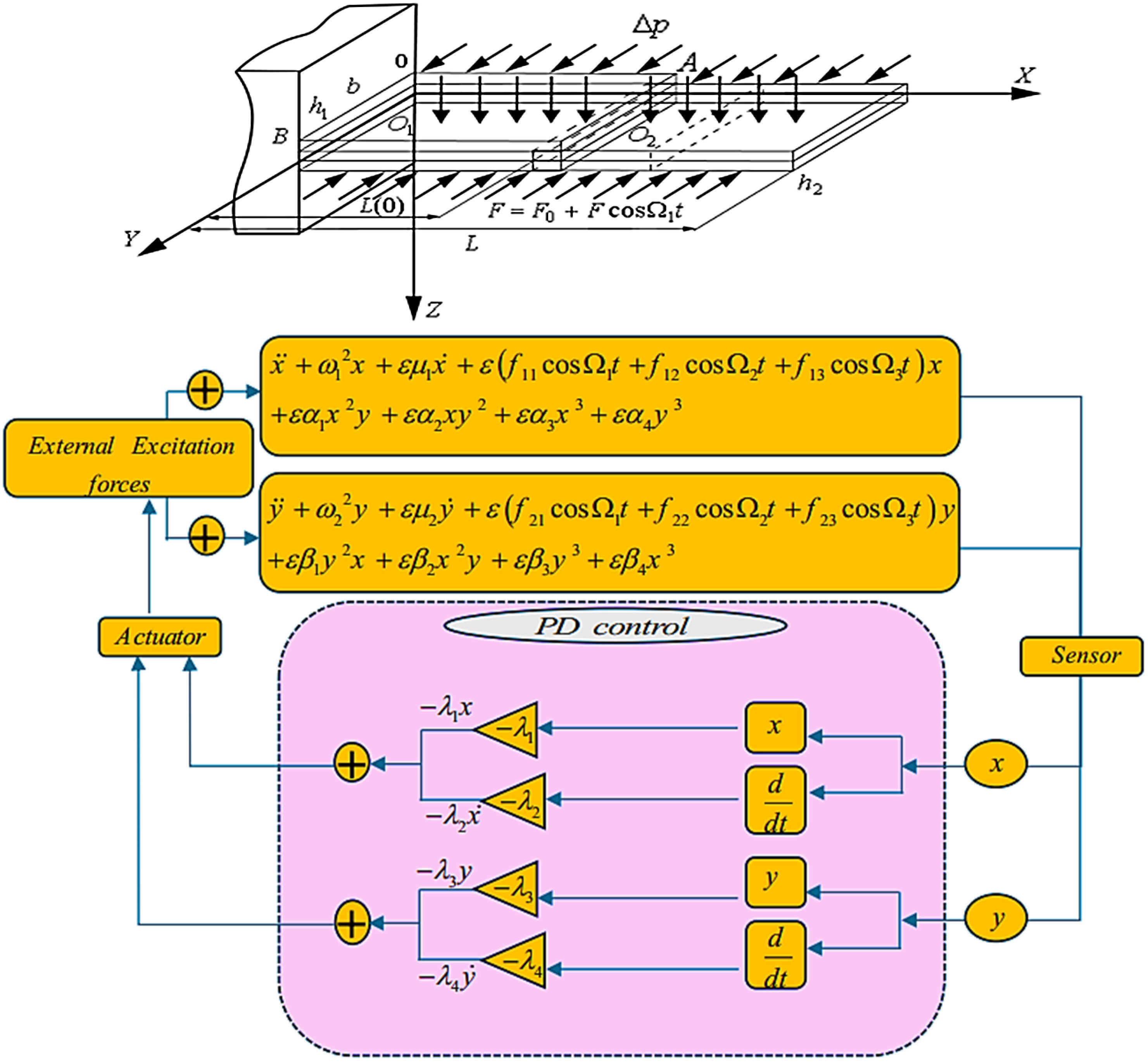
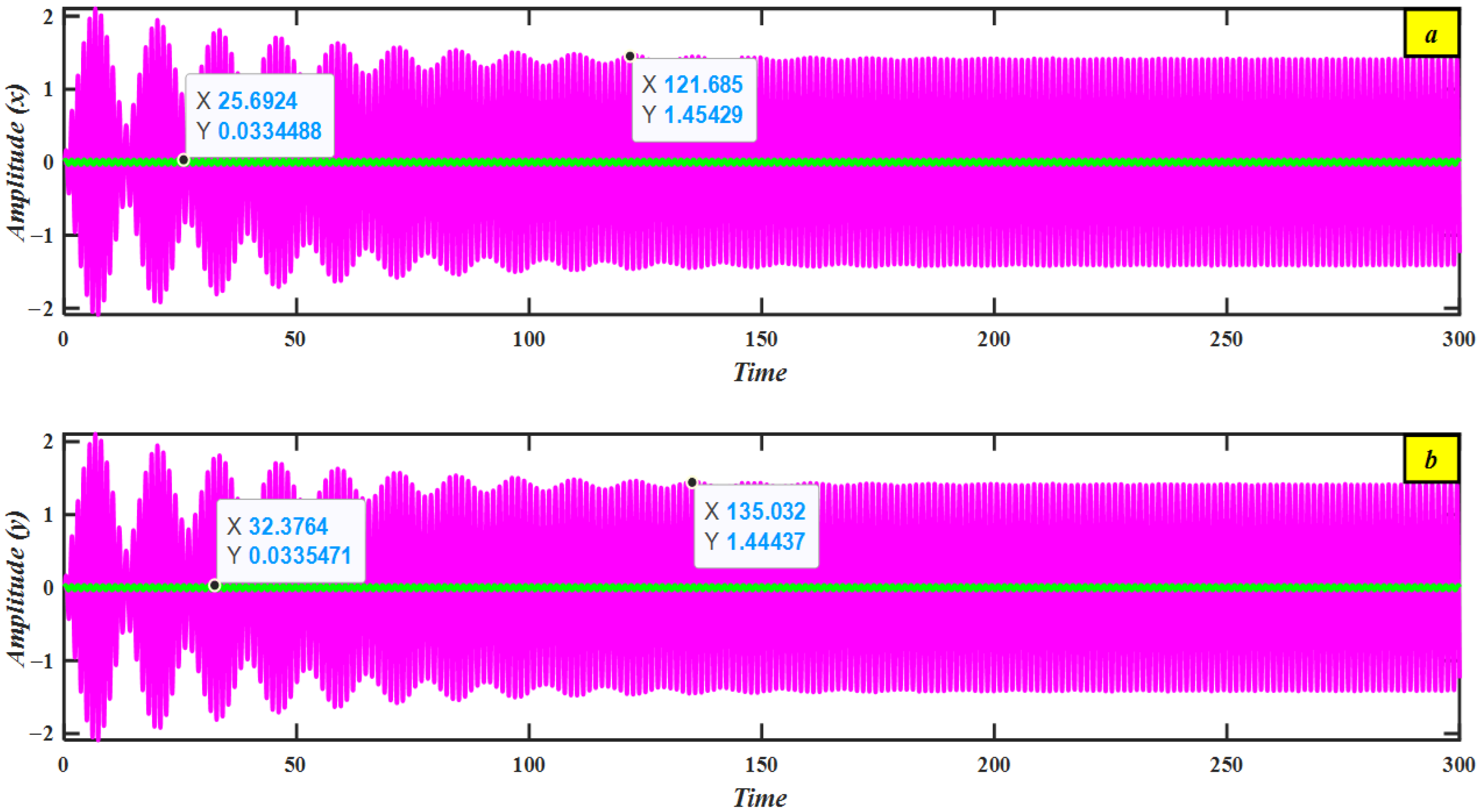


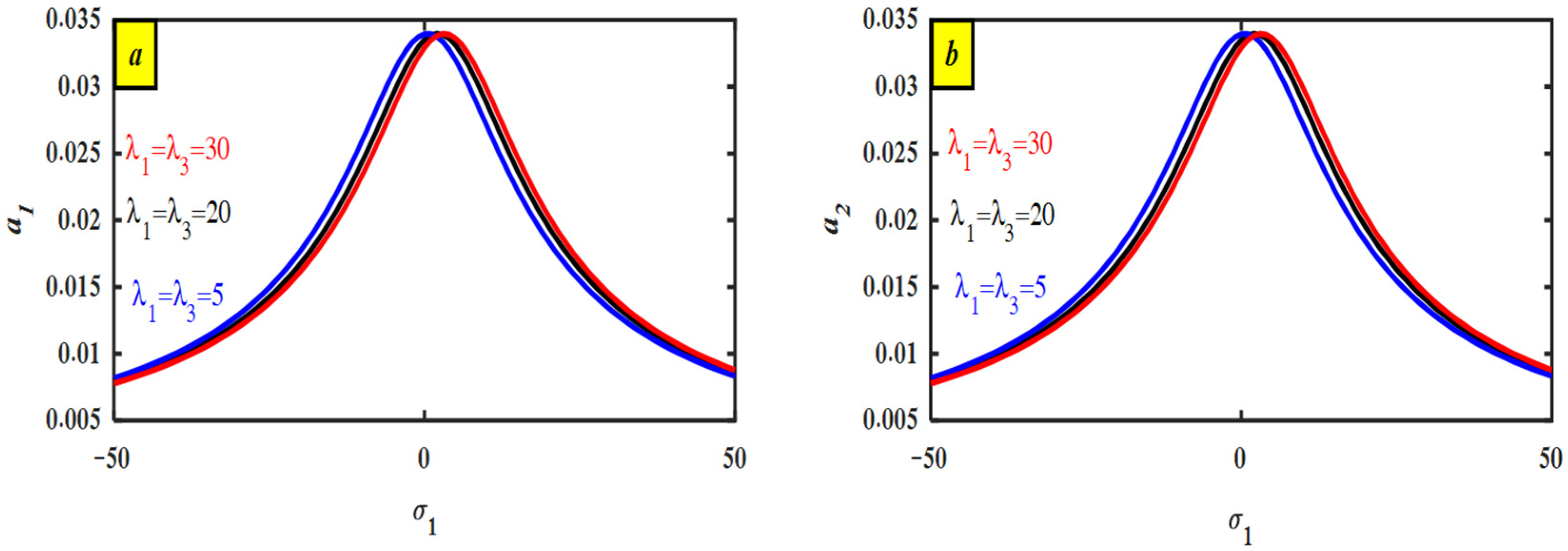


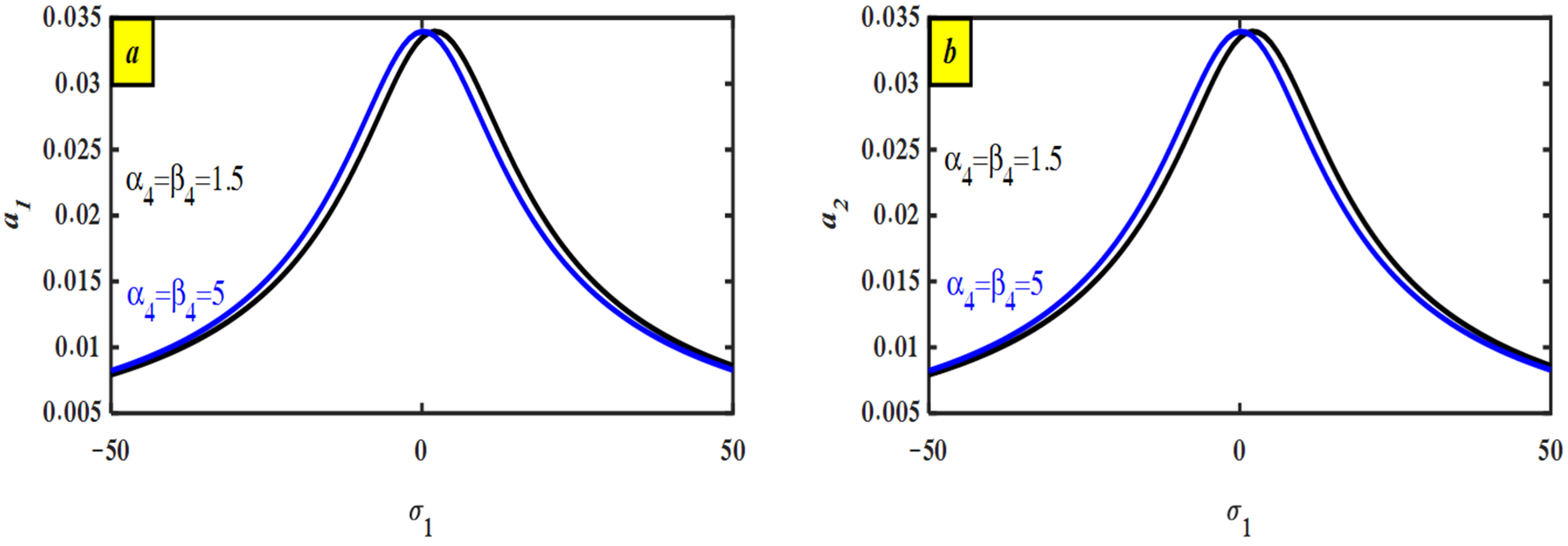

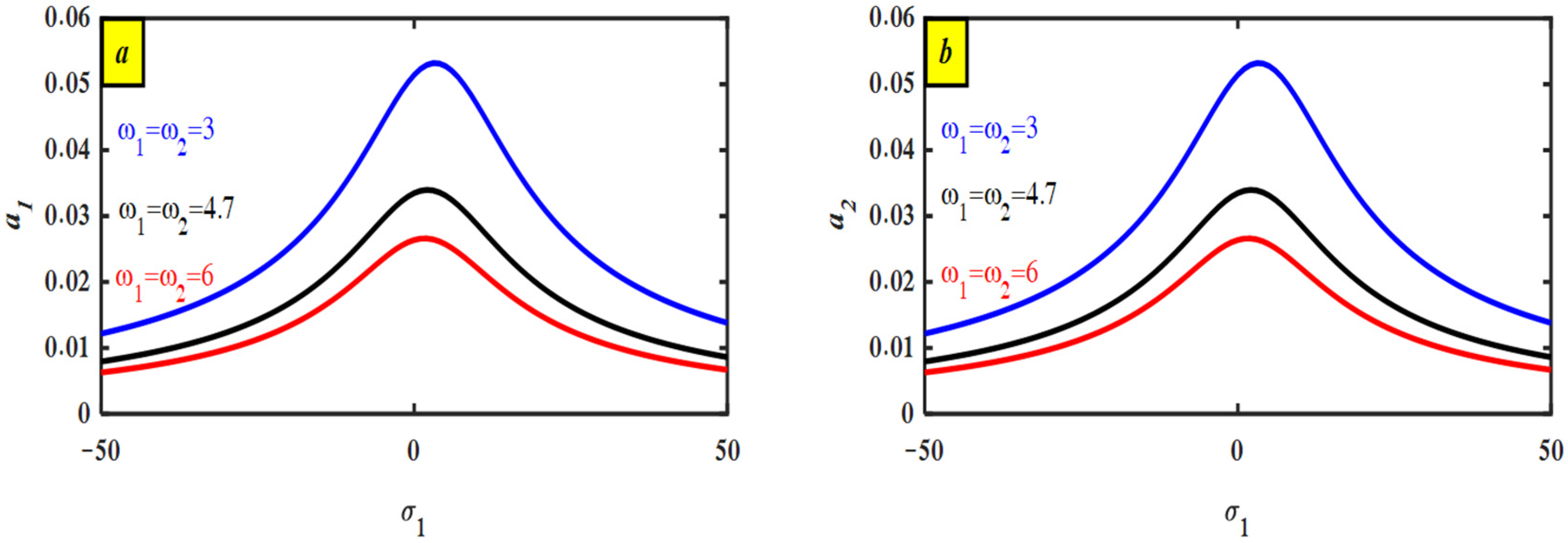



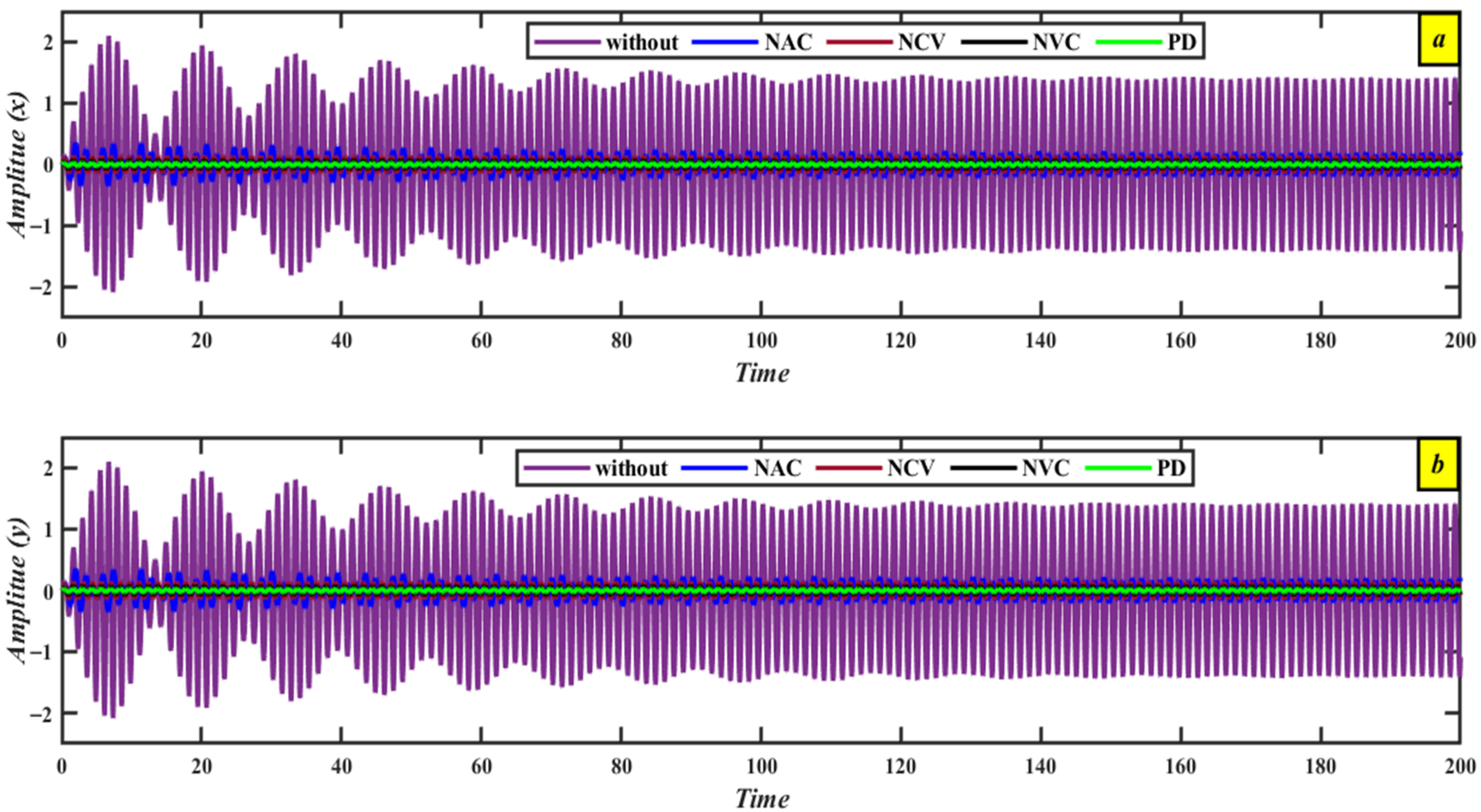

| Value | First Mode of the System | Second Mode of the System | ||
|---|---|---|---|---|
| Numerical Solution | Approximate Solution | Numerical Solution | Approximate Solution | |
| A | 0.0334949 | 0.0334949 | 0.0334946 | 0.0334946 |
| B | 0.0334945 | 0.0334945 | 0.0334945 | 0.0334945 |
| C | −0.0334897 | −0.0334897 | −0.0332704 | −0.0332704 |
| D | −0.0334947 | −0.0334947 | −0.0334946 | −0.0334946 |
Disclaimer/Publisher’s Note: The statements, opinions and data contained in all publications are solely those of the individual author(s) and contributor(s) and not of MDPI and/or the editor(s). MDPI and/or the editor(s) disclaim responsibility for any injury to people or property resulting from any ideas, methods, instructions or products referred to in the content. |
© 2025 by the authors. Licensee MDPI, Basel, Switzerland. This article is an open access article distributed under the terms and conditions of the Creative Commons Attribution (CC BY) license (https://creativecommons.org/licenses/by/4.0/).
Share and Cite
EL-Sayed, A.T.; Hussein, R.K.; Amer, Y.A.; EL-Sayed, M.A. Stability Enhancement and Bifurcation Mitigation in Nonlinear Inner Plate Oscillations Through PD Control. Machines 2025, 13, 828. https://doi.org/10.3390/machines13090828
EL-Sayed AT, Hussein RK, Amer YA, EL-Sayed MA. Stability Enhancement and Bifurcation Mitigation in Nonlinear Inner Plate Oscillations Through PD Control. Machines. 2025; 13(9):828. https://doi.org/10.3390/machines13090828
Chicago/Turabian StyleEL-Sayed, Ashraf Taha, Rageh K. Hussein, Yasser A. Amer, and Marwa A. EL-Sayed. 2025. "Stability Enhancement and Bifurcation Mitigation in Nonlinear Inner Plate Oscillations Through PD Control" Machines 13, no. 9: 828. https://doi.org/10.3390/machines13090828
APA StyleEL-Sayed, A. T., Hussein, R. K., Amer, Y. A., & EL-Sayed, M. A. (2025). Stability Enhancement and Bifurcation Mitigation in Nonlinear Inner Plate Oscillations Through PD Control. Machines, 13(9), 828. https://doi.org/10.3390/machines13090828








